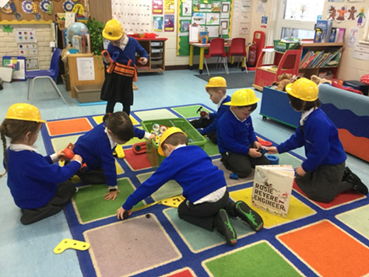Children’s early education sets the foundations for their learning and life outcomes. At our Early Words Matter conference 2025, early years educator and Froebelian expert Dr Stella Louis emphasised that, while early education is often perceived as simply preparing children for the next phase in life, it is of course a crucial stage for supporting the development of key cognitive skills. As Dr Louis stated, ‘A child’s need for interaction and learning is now.’ Every interaction a child has with the world around them presents a chance to develop key problem solving and language skills.
How can you identify and maximise these opportunities, and empower learning in ways that support children’s individual needs?
We’re thrilled to have Dr Louis join us with a guest blog for TeachBrief. Dr Louis will introduce the concept of schema learning and how this can enhance cross-curricular teaching, across nursery, early years and Key Stage 1/Phase 1 & 2.
At the end of this article, find reflections from the Early Years team at the National Literacy Trust, including further practical examples of how to apply schematic learning to your work with children with a focus on language. There are also resources to support your practice in the setting, including partnership work with families and carers.

By spotting children's schematic behaviours, educators gain insight into how they think and learn.
Unlocking the power of schema learning: Guest blog from Dr Stella Louis
Schema learning is a fascinating phenomenon that reveals the intricate ways in which children think, learn, and make sense of the world around them. By observing and understanding the schematic behaviours of children, educators can gain valuable insights into their cognitive processes and tailor their teaching to meet their individual needs. Schema learning is particularly relevant in the Foundation Stage and Key Stage 1, where children are developing their understanding of mathematical and scientific concepts.
Why is schema learning important?
Schema learning is essential for children's cognitive development, as it allows them to build on their existing knowledge and skills, and develop a deeper understanding of the world around them.
Dr Stella Louis
By recognising and supporting schematic behaviours, educators can create a more responsive and effective learning environment that meets the unique needs of each child.
What role do educators have in schema learning?
As educators, we have a pedagogical responsibility to take children from known to unknowns, from concrete to abstract thinking, in meaningful ways. This involves providing children with opportunities to engage in hands-on, experiential learning that builds on their existing knowledge and skills. By doing so, we can help children develop a deeper understanding of complex concepts and relationships and foster a lifelong love of learning.
What are the types of schemas?
There are several types of schemas that are particularly relevant in the Foundation Stage and Key Stage 1:
- Ordering Schema involves making comparisons and learning to use words to describe comparisons, such as big, bigger, biggest.
- Dabbing Schema involves creating patterns or representations using dabs or marks.
- One-to-One Correspondence Schema involves matching things together, such as counting objects.
- Positioning Schema involves understanding spatial relationships and positioning objects in a specific way.
- Orientation Schema involves understanding and exploring different spatial perspectives and relationships.
- Clashing Trajectory Schema involves exploring the movement and trajectory of objects, often with a focus on collision and impact.

Children explore the world through different schemas - like ordering, positioning, matching, and movement - each revealing how they think, learn, and make sense of their surroundings.
How can I support schema learning in the classroom?
To support schema learning in the classroom, educators can use a range of strategies, including:
- Observing and understanding children's schematic behaviours
- Providing opportunities for children to engage in meaningful play and exploration
- Using language and communication opportunities to support children's learning and development
- Incorporating schema learning into teaching practice to create a more child-centred learning environment
Conclusion
Schema learning is a powerful approach to teaching and learning that recognises the importance of understanding children's prior knowledge and experiences. By acknowledging and building on what children already know and can do, educators can create a more effective and engaging learning environment. By incorporating schema learning into teaching practice, educators can provide children with a strong foundation in mathematics and art, and help them develop critical thinking, problem-solving, and creativity skills.
Key questions to consider
- What schematic behaviours are evident in my students' play and learning?
- How can I build on children's existing knowledge and skills to create more effective and engaging lessons?
- What strategies can I use to support children who are demonstrating schematic behaviours, and how can I extend their learning?
- How can I use schema learning to inform my teaching practice and create a more child-cantered learning environment?
By exploring these questions and gaining a deeper understanding of schema learning, educators can create a more responsive and effective learning environment that meets the unique needs of each child.

Noticing schematic behaviours helps educators tailor lessons, support individual learning journeys, and create more child-centred classrooms.
How to support schema learning in the classroom: reflections from the National Literacy Trust's Early Years team
Babies and young children use movement and expression to communicate their ideas and feelings about the world around them. As we grow older, much of our communication continues to be non-verbal. So, when children engage in schematic behaviour, we can view this behaviour (as all behaviours children exhibit) as a form of communication.
When adults notice and respond to schematic play, it creates powerful opportunities for early language development.
National Literacy Trust
When children are interested in something, they are both more likely to choose to talk about it, and to listen and respond to what adults say about it. Repetition, a strong feature of schematic play, is also central to developing language. Hearing the same words in slightly different but meaningful contexts helps children consolidate their understanding.
- Observing and understanding children's schematic behaviours
Taking time to observe, reflect on, and discuss children’s play and interactions within the learning environment will support the identification of schematic behaviours.
Once identified, these can be used to build tailored, language-rich experiences that match children’s interests and extend their vocabulary.
- Providing opportunities for children to engage in meaningful play and exploration
Children benefit from extended periods of uninterrupted time to become fully absorbed in self-chosen play, within carefully planned learning environments.
Observations of schematic behaviours provide an opportunity to review and enhance provision.
Reflect on whether the environment is supportive of children’s interests and if it allows children to explore their schematic learning in different ways.
For example, offering a range of materials in different areas not only deepens meaningful play and exploration for schematic play, but also creates opportunities for language, by hearing, repeating and using new vocabulary.
- Using language and communication opportunities to support children's learning and development
When joining or commenting on children’s schematic play, it should be done cautiously and sensitively, noting children’s responses.
Adults can scaffold language by narrating actions, asking open-ended questions, and introducing new vocabulary in context.
Describing and discussing what’s happening will both support children’s understanding, and their ability to explain and share their own thoughts, ideas and hypotheses.
- Incorporating schema learning into teaching practice to create a more child-centred learning environment
Reflecting on and reviewing provision in relation to schematic behaviours provides the opportunity to continually enhance the learning environment, as well as routines and boundaries. It enables practitioners to ensure the environment is meeting the needs of all children.
Providing open-ended resources (including natural and reclaimed materials) which support various schemas invites exploration and language use.
Sometimes schemas, such as transporting, can challenge rules and routines; discussing these as a team can lead to creative ways to support children’s curiosity while keeping boundaries in place.

Educators can support schema learning by observing play, enriching environments, using language thoughtfully, and creating child-centred spaces that nurture curiosity.
About Dr Stella Louis
Dr Louis is an early years consultant, trainer and author. Her publications include Observing Children in Early Childhood (Sage Publications, 2022) and, with Hannah Betteridge, Let’s Talk About Race in the Early Years (Routledge, 2024). Dr Louis leads a small team of Froebelian traveling tutors and has worked both in the United Kingdom and internationally to develop a Froebelian approach to teaching and learning.
How can you implement schema learning in your setting? Resources to support your early education practice:
Early learning: 10 reasons why play is important: This resource contains information and materials to help enhance play in your early years or KS1/P1-2 setting.
Chat, play, read booklets: Suitable for babies and toddlers aged 0 to 3 years old, this booklet is filled with simple activities including songs, games and ideas for chatting that can be incorporated within daily routines at home. It’s also available in 19 different languages for you to share with the multilingual families in your setting or community.
